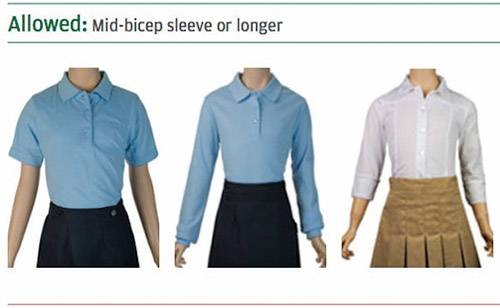
In the best of all worlds scenario, there would be one standard for how one dresses. Not regarding specific garments, but rather an understanding and appreciation of how we as reflections of the Divine ought to comport ourselves. A young woman can be covered from head to toe, but if it is in a form fitting outfit it is certainly not considered modest. Similarly, a young man in soiled jeans, backward baseball cap and untucked shirt doesn’t fit the image of a ben Torah. Parents and children seem to have accepted that there are different norms for school and shul, than there are for at home.
Orthodox schools and Orthodox camps struggle with the issue of dress codes. Many parents do as well, and often students chafe at clothing guidelines. Is there a standard to which everyone can adhere? Is there a uniform (no pun intended) set of rules that applies in all circumstances and in all school settings? Are these standards the same at summer camp? Why does it seem that dress codes focus more on girls than on boys? Is there a dress code for parents who visit school? Is there one for faculty?
An Orthodox school or camp is expected to follow certain norms. Basically, they should follow halacha if they call themselves Orthodox. The food they serve is strictly kosher, there are mezuzot on all the doors and they are closed on Shabbat and Yom Tov. How we dress is also a matter of Jewish law. It’s not just the issue of modesty, because tzniut is more of a mindset and attitude than it is hemlines or shirtsleeves. A contemporary phenomenon in some Modern Orthodox circles is selective observance. Kashrut, belonging to an Orthodox shul, sending kids to day schools, keeping Shabbat and Yom Tov and going to a mikvah seem to still be acceptable. However the manner in which one dresses away from shul, speaks, spends one’s leisure time, devotes effort to studying and other ancillary aspects of observance appear to be optional.
Certain areas of Jewish law and practice are very clear. In Modern Orthodox circles some grey areas have emerged. Whether these are objectively Orthodox or subjectively Orthodox will be determined over time. Do all schools require married female teachers to cover their hair? May girls sing in a school choir? Why is it that in all Orthodox girls summer camps they dress the way they do in school, while in coed Orthodox camps girls and boys can almost wear whatever they want except for Shabbat? (With the possible caveat that long pants or skirts be worn to morning prayers.)
Let’s focus on boys. It is mandatory that they wear tzitzit and a kippah. Is there an acceptable size for a kippah? Rav Moshe Feinstein says there is, but most schools rarely implement this standard. Most schools do not allow denim dungarees, but other colored jeans are okay. Sneakers have become acceptable footwear. Collared shirts are required in most schools. In co-ed camps for some reason, after davening, tzitzit become optional. In all Orthodox boys camps tzitzit are worn all the time.
As far as girls are concerned, we run the gamut from right to left. Collared long sleeve blouses buttoned up, skirts below the knee, pantyhose, tights, or over the ankle socks, no makeup and no flip flops are the standard in some schools. The variations include short sleeves, top button open, skirts to the knee, some makeup and socks optional. In coed Orthodox camps, it has become difficult to control how girls dress. In most such camps shorts are getting shorter and except for Shabbat, they dress like any other girls not bound by Jewish law and practice. The boys aren’t much better.
The values and lifestyle of the parents complicate the issue for schools and camps. If parents dress a certain way, their children will see no reason not to emulate them.
Granted schools should have standards, but in today’s culture it’s getting harder and harder to implement them. Camps want to fill bunks and schools want enrollment. However, standards will attract those parents for whom values are important.
The clothing that children wear to school also has a competitive component. Last year’s styles are out. The latest styles in footwear and other items of clothing can foster a great deal of peer pressure for boys as well as girls. Every parent knows the hassle of getting children dressed for school. Tuition is high enough without the added cost of the latest outfits, as well as keeping up with the ever changing vagaries of fashion and style.
One solution of course is school uniforms which many schools have adopted in one form or another. Either a certain color of shirt or blouse and pants or skirts or a full uniform with the school logo. Despite all the arguments about self-expression, studies have shown that kids learn better when they look good without the peer pressure that is generated by the style setter cliques.
Dress codes exist for a reason. Schools have every right to demand that certain standards be maintained. Each school will determine that standard for their population. Enforcing dress codes may be unpopular. Forcing girls to wear an “office skirt” when sending them home may not be an option and is an experience that generally will not be repeated. The same is true for boys who have to wear an unflattering shirt or oversized tzitzit.
Some parents may not like being told what their child can and cannot wear. At home they can wear whatever they choose. At school, the rules are set by the school. Ideally there should be no conflict between school and home. At least that’s the theory.
By Rabbi Dr. Wallace Greene
Rabbi Dr. Wallace Greene has had a distinguished career as a day school principal and educational administrator.










